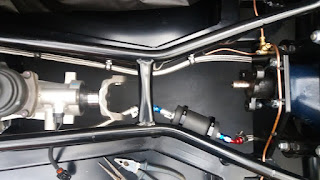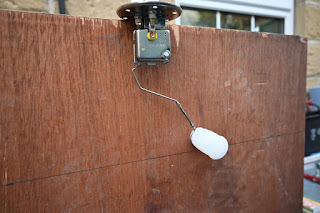If you have one from Roadcraft, the steering pump hose connection will look like this:

If it isn't obvious from the pic, I'll tell you that it is nigh on impossible to connect the hose with the pump in place. The trick is to take the short connector from the hose joint and screw this into the steering pump before the pump is fitted to the engine.

After the pump is installed, there is just enough room to get the nut on the hose joint tightened up onto the connector before installing the belt

Now the steering pump hoses can be fully connected

Starter Motor
 The starter motor is mounted to the engine block. There should be approximately a 1/4" inch gap between the flywheel ring gear and the motor gear. This is so the motor gear is very much out of the way after the engine starts. It is easy to do if you have the motor to hand before fitting the bell housing. In my case I had to remove the motor from its bracket, measure the distance from the surface of the bell housing to the flywheel ring gear, and compare with the mating surface on the motor to the edge of the motor gear. The measurement was ok and Brian at Roadcraft says these things normally do not require adjusting, but the motor comes with packing spacers in case.
The starter motor is mounted to the engine block. There should be approximately a 1/4" inch gap between the flywheel ring gear and the motor gear. This is so the motor gear is very much out of the way after the engine starts. It is easy to do if you have the motor to hand before fitting the bell housing. In my case I had to remove the motor from its bracket, measure the distance from the surface of the bell housing to the flywheel ring gear, and compare with the mating surface on the motor to the edge of the motor gear. The measurement was ok and Brian at Roadcraft says these things normally do not require adjusting, but the motor comes with packing spacers in case.Radiator and hoses
The radiator fan was fitted to the upper and lower radiator mounting brackets supplied by AK.
The fan assembly comes with a few different mounting brackets which slot into the fan surround.
So drill and tap four holes in the appropriate places on the upper and lower rad mounts.

In this pic, the fan motor wires are exiting on the offside side of the fan motor.
What we learn when we get the AK wiring loom is that the wiring for the fan is bundled with the nearside leg of the wiring loom which supplies the lights on the nearside, and will in fact be within the nearside wheel arch. So if possible, fit the fan such that the wiring exits the fan housing towards the nearside. That will make it easier to connect to the wiring loom later.
The radiator mounting needs to be rubber insulated from the metal mounting brackets or else vibration is likely to crack the rad over time.
The lower mounting pins need this rubber mount:
 Part no. 572312A from Rimmer Bros.
Part no. 572312A from Rimmer Bros.The top mounts need a rubber washer.
I used part no. 500447 from Rimmer Bros and then cut it in half to get the correct thickness for the top mount.
In fitting the rad, make sure it fits without being twisted out of shape. I had to re-form the top AK supplied mounting bracket so it would line up with the screw holes in the rad. And also such that when the mounts are tightened down there should be no stress or twisting motion on the rad.
Note the bottom outlet pipe from the rad. It may possibly interfere with the lower mounting bracket. Cut away a small corner of the bracket if so.
The hoses supplied by AK fit well after being cut to correct length. Use a very sharp Stanley knife.
A jubilee clip can be put round the hose to guide the knife cut.
When fitting the jubilee clips think about access to the screw head after the car is built. It will be from underneath or in through the bonnet. Position them such that you will be able to access the screw head.
The top chrome pipe is secured to the chassis arm with a 38mm P-clip.
The lower chrome pipe is possibly done the same way but I didn't like the way it was holding the pipe. I wanted a strong clamp that surrounds the pipe, something like a saddle clamp. And what I found is actually called a 'Cobra Pipe Clip'. How serendipitous. I had to get me one of those.
And here it is:

Mount the header tank to the right hand side to make way for the air inlet pipe when I have the money to buy it!



Around this time, if you have an idle motor with a cable operated throttle, you may want to think about fitting it now. It comes with an Omex kit from AK. Ideally it mounts on back side of the chassis cross member under and to one side of the header tank. It has two hoses coming up off it so consider its position in relation to the header tank and the large air inlet tube.
This is it here:


One of the hoses goes to the front port on the air inlet tube.

The other hose goes to the port upstream of the throttle body that was vacated when you removed the EVAP sensor.
Exhaust Headers
If you have a crate engine in the UK, it will probably have headers that need changing to fit the AK chassis. Roadcraft can source new ones, I obtained a used pair from a Ebay dude in the States.

Had them media blasted to get the rust off. And then due to the top chassis rail on a GenIII chassis cut/grind the heat shield mounting lugs down. Then paint with very high temperature POR paint (thanks James).

The bolts securing the original headers appeared to have some form of thread lock from the factory.
I couldn't find any thread lock that will put up with the temperatures we will get here (~800c +).
Several internet forums in the States talk about not using thread lock but to use a small dab of copper grease so as to stop the metal/all corrosion happening. If we find the manifold blowing after some mileage, it may be due to the header gasket relaxing and the retaining bolts may need to be tightened.
Dipstick
This caused me a lot of problems.
As we have changed the sump, we also need a dipstick (DS) and tube which will properly measure the oil level in this sump. As I had the parts supplied from Roadcraft instead of having them pre-fitted, I had the original DS and its tube as well as the new one.
In order to get the new tube to fit, it has to be modified to bend around the now changed exhaust headers. The bracket that screws it to the engine block is now useless. I cut it off.
Originally I planned to create a new bracket with a hole and rubber grommet for the tube.
The two problems are that the rubber will probably melt, and it won't hold the tube securely, allowing it to possibly rise up out of the hole in the sump.
So I had to weld it. I have used oxy-acetylene years ago but I don't have the equipment for that at home. I only wanted to braze it anyway due to the thinness of the tube. I bought the kit to use a propane flame from the space heater but it was hopeless. It takes so long to get the heat up that oxides start forming ruining any braze joint that might have happened if I could get it hot enough.
There is a lot of Internet advice about brazing with propane, don't believe it. You will need oxygen.
The Welders Wharehouse (google it) sell a Oxy-Gasex kit. This deliveres a 3000+ degree C flame with a nice blue tip that works very well. It may be possible to weld 1mm - 2mm steel as well but probably only with autogenous welding (without use of a filler material).
When bending the tube, make gentle curve adjustments or else nothing will get down it if the bend is too acute.
Now, after bending the tube to suit, you'll probably find the DS itself will no longer fit down the tube. That is because it may be of a flat blade type. I used the original, longer, twisty DS but cut to correct length. The original one is made using twists instead of flat blade.

It means it can bend in any direction and so will slide down the tube. If you don't have the twisty type, the original flat blade can probably be warmed up and twisted to form the twist shape.

The longer twisty but now cut to length DS is below in the pic above. I drilled two tiny holes to mark the upper and lower levels the same as the flat blade DS that should be used
The bracket I made is bolted to the engine block and brazed to the DS tube. Painted with high heat POR (Thanks again James).

I have to say it is not my most elegant work, but it will do the job.






































